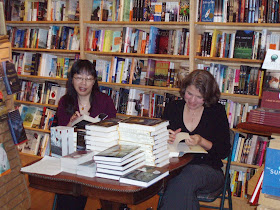(Above: the Prince Regent, photo from Wiki Commons)
I’m reading PURPLE SECRET: Genes, ‘Madness’ and the Royal Houses of Europe, by John Rohl, Martin Warren, and David Hunt (London: Bantam Press, 1998). The purple secret is, of course, the metabolic disorder porphyria, which entered the royal house of Britain (and therefore the rest of Europe) though Mary Queen of Scots.
The “Mad” King George III has unarguably done more to popularize porphyria than anyone else. Unfortunately, his well-known identification with “madness” has led the disorder to be associated in the popular mind with insanity. In fact, a porphyria attack can cause depression, anxiety, and confusion (because it interferes with the serotonin pathways). But full-blown mental illness caused by porphyria is rare and typically associated with some other, simultaneously occurring condition.
Porphyria is a genetic disorder affecting the enzymes responsible for the synthesis of porphyrins into heme. There are various types of porphyria, depending upon which enzyme in the pathway is affected. Some types of porphyria are associated with abdominal pain (acute porphyria), others can cause the skin to develop a weeping rash when exposed to the sun (cutaneous porphyria). George III undoubtedly suffered from variegate porphyria, which causes both. Symptoms of acute porphyria include attacks of severe abdominal pain and peripheral neuropathy, which basically means it effects the body’s non-conscious functions such as the heart, lungs, etc, causing general muscle weakness, numbness, difficulty breathing, and an increased heart rate. In other words, it’s like being hit with the worse case of flu or food poisoning you can imagine. Porphyria attacks can be triggered by exposure to chemicals (including heavy metals, alcohol, and many pharmaceuticals), female hormones (either during a woman’s regular cycle or pregnancy), fasting or high protein/low carbohydrate intake (i.e., Atkins or South Beach diets), fever and viral infections, or stress. An attack sometimes—but not always—causes the urine to take on a reddish tinge as the body attempts to throw off the accumulating porphyrins (which are toxic in large quantities); hence the “purple” secret.
George III’s five bouts of “madness” are notorious, but less well known are the life-long sufferings of most of his 13 children, including the Prince Regent himself. The authors use the royal family’s personal letters and doctors’ reports to detail the long illnesses of the princes and princesses. It makes for scary reading (the treatments often being scarier than the symptoms they were used to treat). In fact, the illnesses of George III’s children were of such long duration—sometimes lasting years—and so extreme that I personally think something else was going on there in addition to the porphyria.
As for George III, recent chemical analysis of his hair has shown that the poor man was suffering from arsenic poisoning. A 2005 article published in the British medical journal LANCET (written by Martin Warren, one of the authors of this book) reported the presence of arsenic at over 300 times the toxic level in George III’s hair. At the time, arsenic was used in both skin creams and wig powders, but even that couldn’t account for George III’s high levels. It seems that the King’s doctors were treating his porphyria attacks by giving him something called “James’ Powders,” which was made from antimony containing significant traces of arsenic. Like a good king, he took what his doctors ordered, several times a day. Ironically, arsenic is one of the triggers for a porphyria attack. In other words, they were treating his porphyria attacks with a substance that causes porphyria attacks, in addition to being toxic itself. Another common remedy of the time, mercury (“calomel”) also causes porphyria attacks (which is why anyone with porphyria should avoid modern vaccines containing traces of mercury and get rid of their mercury fillings, if possible).
The royal houses of Europe obviously decided long ago to close ranks on the subject of the “family” malady. The authors (a combination of historians and microbiologists) were repeatedly refused access to papers and medical samples. But they have easily traced the symptoms of the disorder down through Queen Victoria, to her children and grandchildren, all the way to Princess Margaret. Only Prince William of Gloucester (a grandson of George V) made no secret of his diagnosis of porphyria, which manifested itself after he took chloroquine to prevent malaria in Africa.
Unfolding like a detective story, the book makes fascinating reading, even if you don’t suffer from porphyria. The royal families’ secrecy on this subject is unfortunate, since they could help to publicize the truth about a disorder that has become associated in the popular mind with madness, werewolves and vampires. The disorder is actually far more common than was previously thought. Unfortunately, most American doctors are woefully unfamiliar with porphyria, and most people don’t know they have it until they take something that almost kills them.












